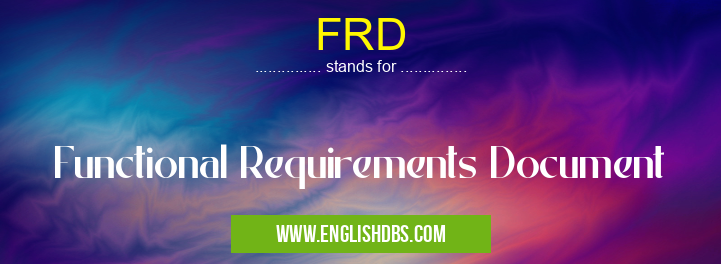What does FRD mean in MILITARY
A Functional Requirements Document (FRD) is a document that articulates the specific functional requirements, or what a system must do, for a given business solution. FRDs are typically used as part of the development process for large-scale information systems and software projects. The purpose of an FRD is to ensure that stakeholders involved in the project understand the desired functionality and any associated technical requirements needed to complete it successfully. FRDs inform design, development, testing, deployment, and maintenance activities during the course of a project's life cycle.

FRD meaning in Military in Governmental
FRD mostly used in an acronym Military in Category Governmental that means Functional Requirements Document
Shorthand: FRD,
Full Form: Functional Requirements Document
For more information of "Functional Requirements Document", see the section below.
» Governmental » Military
GOVERNMENTAL Use
In government, functional requirements documents (FRD) are an essential tool when creating digital systems. This type of document outlines the roles and actions that an individual can take within a given system. It also helps to define aspects such as security protocols and authorizations for data access. For example, when designing a voting registration system for a government agency, an FRD would specify how easy it is to enroll in an election and what documents are necessary to verify eligibility. By incorporating this information into an FRD upfront, developers can work towards creating a secure and accessible system that meets all legal requirements from the get-go.
Essential Questions and Answers on Functional Requirements Document in "GOVERNMENTAL»MILITARY"
What is a Functional Requirements Document (FRD)?
A Functional Requirements Document (FRD) outlines the specifications and functional requirements of a product, service or system. It defines what the product, service or system should do and how it should be implemented to meet the business needs. It typically includes a description of the functions to be performed, input/output information, performance requirements and other technical specifications.
Why is an FRD important?
An FRD is important because it allows everyone involved in a project to have a clear understanding of what they are working on, including features and functionality that will be included in the final product or service. It also helps reduce risks associated with misunderstandings by providing specific documentation that clearly outlines all the agreed-upon assumptions and expectations about the project.
Who creates an FRD?
The FRD is usually created by a Business Analyst, Project Manager or System Analyst, depending on the type of project being undertaken. The document is created using discussions between stakeholders in order to define their exact needs for a given project. This ensures all necessary requirements are documented before any development begins.
What should be included in an FRD?
An FRD should include detailed descriptions of each function or feature being requested by stakeholders with reference to how they plan to use it; input and output information; user types/personas; data flow diagrams; security requirements; dependencies such as hardware or software; performance standards expected from the system; user interfaces with example screen shots if available; special notes regarding particular processes; audit trail for accountability etc.
How long does it take to complete an FRD?
The duration of an FRD depends on its scope and complexity but normally takes anywhere from days to weeks depending on how much detail is required for each requirement.
Is there anything else I need before starting work on an FRD?
Prior to beginning work on an FRD it is important that you have access to all relevant stakeholders both internal and external who can provide critical information about their expectations for the project so that all aspects can be accurately documented within the document itself.
How do I ensure my requirements are accurate when documented in my FRD?
When documenting your requirements within your FRD it is important that you ask questions–is this actionable? Are all parties aware of this requirement? Does this solve our customers’ problem/meet their needs?, etc.–to ensure accuracy . Additionally involving customer subject matter experts when creating your document will add further clarity as well as helping crystalize customer needs into actionable items.
Once complete, what next steps should I take regarding my completed Functional Requirements Document (FRD)?
Once completed, your Functional Requirements Document (FRD) should then be reviewed by stakeholders over several iterations until they are satisfied with its accuracy and acceptance criteria have been met. Following approval from key stakeholders it should then be signed off as complete before any development can proceed accordingly.
Final Words:
In summary, FRDs are powerful tools used by governments around the world in order to create digital systems that meet all security protocols and other specified requirements prior to implementation and deployment into production environments. This document helps define roles and actions before coding begins so developers have everything they need to turn ideas into reality without shortcuts or overlooking important elements needed for success.
FRD also stands for: |
|
| All stands for FRD |
